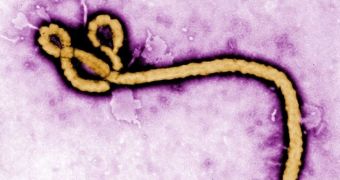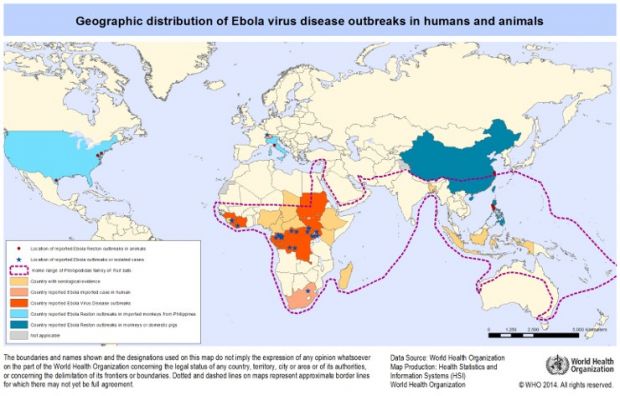Earlier this week, on August 8, the World Health Organization announced that the Ebola outbreak that debuted in West Africa back in December 2013 and that had since killed nearly 1,000 people was the largest ever recorded in history.
Since the first case of Ebola Disease was confirmed in Guinea until present day, the virus has made an appearance in three other countries in West Africa: Liberia, Nigeria, and Sierra Leone. It has infected both locals and volunteers looking to help them.
An Ebola Disease outbreak is not to be taken lightly, even by those who live thousands of miles away from the regions affected by it. As explained by specialists, the virus spreads mind-bogglingly fast, and is therefore a threat to international public health.
Having killed hundreds of people in West Africa over the course of just a few months, it's no wonder that the Ebola virus is now getting quite a lot of bad publicity. I'm here to tell you that, outbreak aside, the Ebola virus is actually a pretty cool little fellow.
What I mean is that, strictly scientifically speaking, this virus is well worthy of our admiration. It's perfectly designed to kill. It's Mother Nature at its best. Granted, in a very bad way, but one has to admit that – again, speaking strictly from a scientific standpoint – its abilities are kind of impressive.
Mind you, I am not saying that the ongoing Ebola outbreak in West Africa is the best thing that has happened to humanity in a long while. People are getting infected and dying, and this is nothing to joke or laugh about. What I want to point out is that the Ebola virus is, in itself, quite a piece of work.
First Off, Some Basic Facts About Ebola
The World Health Organization tells us that the first documented cases of Ebola were recorded back in 1976 in the town of Nzara in Sudan and in the village of Yambuku in the Democratic Republic of Congo, respectively.
Of these two simultaneous outbreaks, the latter was reported close to a waterway dubbed the Ebola River. Since I am nothing if not thorough, I'll go right ahead and state the obvious: the fact that this case was documented close to said waterway is the reason the disease was named Ebola.
Investigations carried out following these two outbreaks led to the discovery of a new group of viruses. Therefore, the so-called genus Ebolavirus comprises five distinct species: Bundibugyo ebolavirus, Zaire ebolavirus, Reston ebolavirus, Sudan ebolavirus, and Taï Forest ebolavirus.
Of these five species, the first three have until now been blamed for Ebola Disease Outbreaks in Africa. The other two, which can be found in the Philippines and in the People's Republic of China, have not yet caused illness or death in humans. This is despite the fact that they can infect people.
The Ebola virus species responsible for the outbreaks documented in Africa since 1976 until present day have been shown to infect people who come into contact with blood, secretions, organs or other bodily fluids of animals carrying such microorganisms in their bodies.
Chimpanzees, gorillas, fruit bats, monkeys, forest antelope and porcupines have until now been documented to act as carriers for Ebola. After infecting a human, the virus passes to other members of the community through direct contact with the blood, secretions, organs or other bodily fluids of infected people, and through indirect contact with contaminated surfaces.
To get a better idea of where Ebola has until now struck, check out the photo below. It was released by the World Health Organization earlier this year, and it shows the geographic distribution of Ebola outbreaks that have so far been documented on a global scale.
The Absolute Worst of the Bunch
Remember when I said that the genus Ebolavirus comprises five different species? Well, of these five species, the absolute worst of the bunch is the Zaire ebolavirus. By the looks of it, this tiny fellow is the one to blame for West Africa's ongoing outbreak. Its mugshot is available next to this article.
The Zaire ebolavirus has an incubation period of 2 to 21 days. It has a fatality rate of 90%, and scientists are yet to develop a cure or a vaccine against it. Due to the fact that this virus attacks the vascular system, the disease it causes it is dubbed hemorrhagic fever.
As already mentioned, specialists are presently clueless about how to cure hemorrhagic fever resulting from Zaire ebolavirus infection. Thus, all they can do is administer treatment meant to ease some of the symptoms associated with this disease. Still, there is no way to prevent death if the infection becomes too much for the body to handle.
In case anyone was wondering, the symptoms associated with Zaire ebolavirus infection include high fever, headaches and muscle aches, stomach pain, and diarrhea. Infected people can also develop a sore throat, and red and itchy eyes. Vomiting and rashes have also been linked to this virus.
During a later stage of infection, the Zaire ebolavirus causes people to bleed from their nose, spit up blood from their lungs, vomit blood from their stomach, and bleed through their eyes. The chest pains and the shock experiences in the last stage of infection are followed by death.
How Does the Zaire Ebolavirus Work?
I have no intention to get into complicated talks about the genetic makeup of the Zaire ebolavirus and bore you to tears with information you'll surely have a hard time remembering the second you click off this page. Also, I have to admit that I myself find it difficult to process such details.
Here is what you should know: once inside the body of its victim, this Ebola virus more often than not effectively suppresses the immune system. What this means is that people die without even getting the chance to try and fight off the disease. As its host is withering away, the virus is pretty much thriving.
Scientists say that, due to the fact that they are not cells, viruses such as Ebola cannot grow through cell division. Thus, they have to find some cell to infect and whose machinery and metabolism to use to produce multiple copies of themselves. While busy producing such copies, the virus attacks the cells lining the blood vessels, which leads to internal bleeding.
Now, we all get paper cuts or all sorts of other cuts every once in a while. Whenever this happens, the body deals with the problem by getting the blood to coagulate. The problem is that, in the case of people infected with Ebola, coagulation becomes very difficult. The result is hemorrhagic fever that eventually leads to death.
“The Ebola virions enter the host cells through endocytosis and replication occurs in the cytoplasm. Upon infection, the virus targets the host blood coagulative and immune defence system and leads to severe immunosuppression,” explains the Public Health Agency of Canada.
So, What Makes the Zaire Ebolavirus So Cool?
First off, I would like to point out the fact that your average Zaire ebolavirus has a diameter of 80 nanometers and a length of 970 nanometers. For those unaware, a nanometer is one billionth of a meter. Simply put, this virus is mind-bogglingly teeny tiny. Still, it somehow manages to kill hundreds of people.
People have been known to survive hurricanes, train crashes, even wars and Justin Bieber concerts. What's more, you'd think that, over the course of thousands of years of evolution, our bodies would be all too well equipped to be able to handle whatever Mother Nature sends their way.
As it turns out, all it takes to kill us is a microorganism that is to tiny that we can't even see with the naked eye. The Ebola virus is so small that some might think that squishing it with a pair of army boots would be more than enough to make it go away forever. These people could not be more wrong.
I don't know about you, but I myself have to admit that I am quite amazed at this little-little virus. It's smaller than a cell, but can take on millions of them and make mincemeat of each and every one. It's almost like having a single cloud play hurricane and end up destroying patches of land.
This is what I mean when I say that, at the end of the day, the Ebola virus, and especially the Zaire ebolavirus behind the outbreak in West Africa, is well worthy of our admiration. Don't get me wrong, the Ebola Virus Disease is nothing short of terrible, but the Ebola virus itself is, in a strange way, sort of fascinating.
These being said, I'll leave you to ponder on how wrong or how right I am when saying that the Zaire ebolavirus should be given some credit for being one of Mother Nature's best killers. Needless to say, you are more than welcome to share your thoughts in the comments section below.

 14 DAY TRIAL //
14 DAY TRIAL // 

